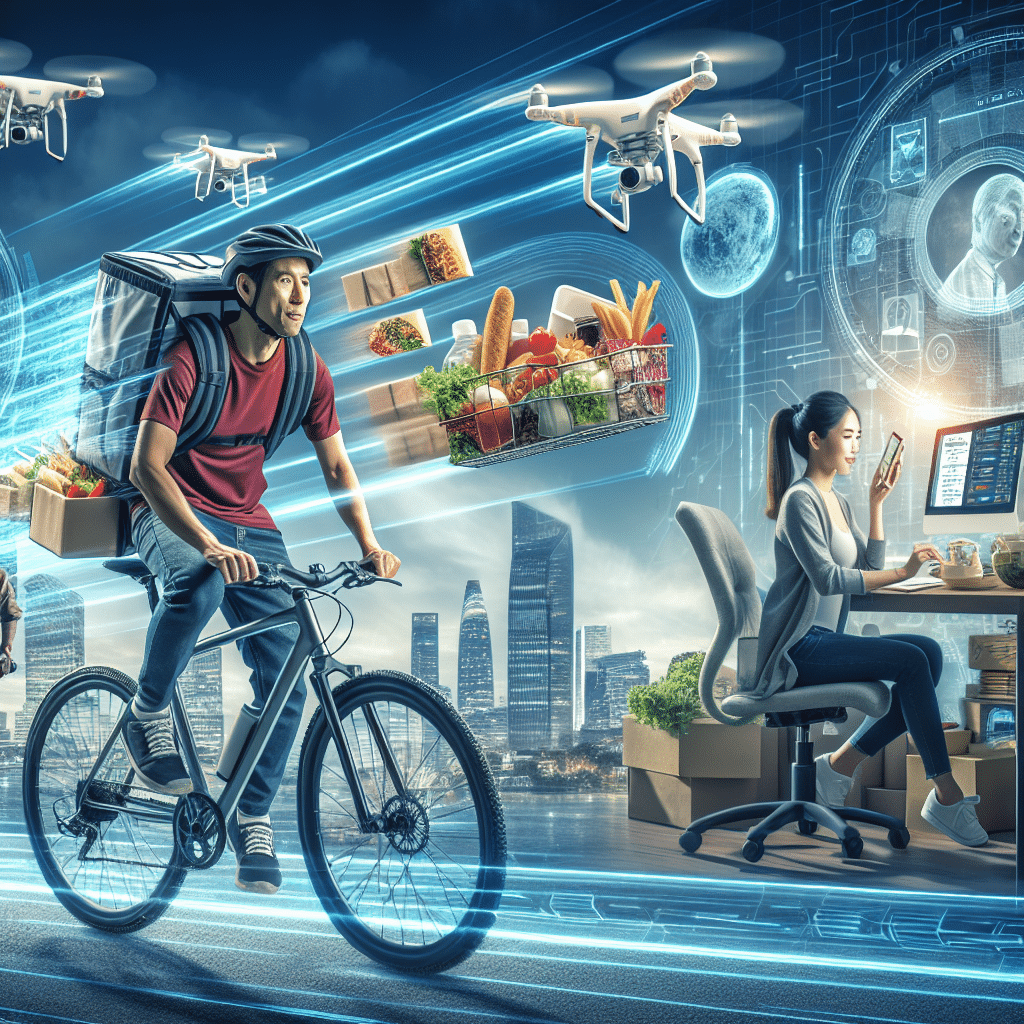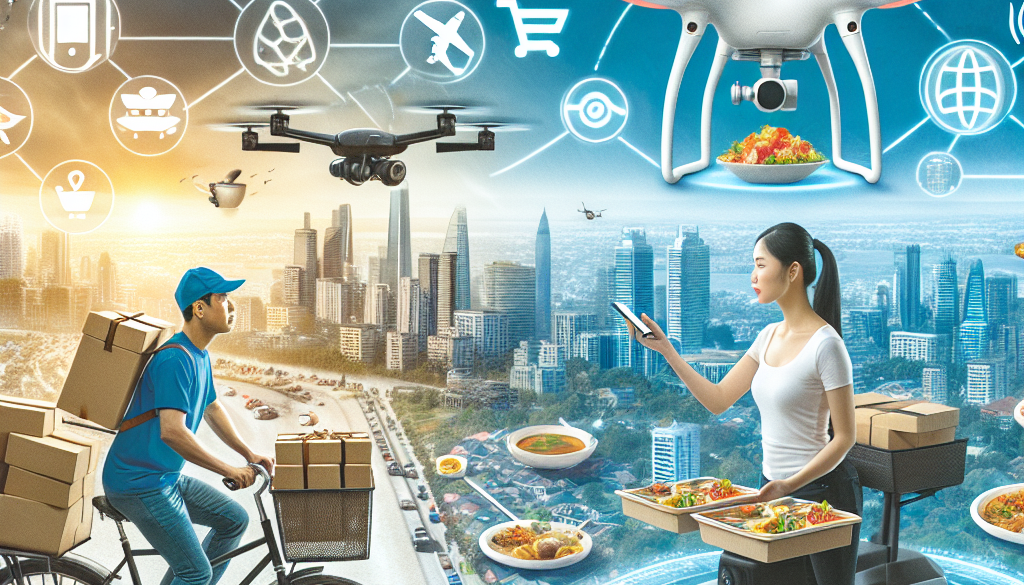Trends That are Transforming the Food Delivery Industry
-
Table of Contents
- Trends Transforming the Food Delivery Industry in 2023
- 1. The Rise of Ghost Kitchens
- 2. Integration of Artificial Intelligence and Machine Learning
- 3. Subscription-Based Models
- 4. Eco-Friendly Packaging and Sustainability Practices
- 5. Expansion of Delivery Options
- 6. Use of Drones and Autonomous Vehicles
- 7. Health-Conscious and Customizable Menus
- 8. Contactless Delivery and Payment
- 9. Increased Use of Data Analytics
- 10. Collaboration with Social Media Platforms
- Conclusion
- Enhance Your Menu with ETprotein’s High-Quality Protein Products
Trends Transforming the Food Delivery Industry in 2023

The food delivery industry has been on a meteoric rise over the past few years, fueled by technological advancements, changing consumer behaviors, and the global pandemic. As we move further into 2023, several key trends are shaping the future of how food is ordered, prepared, and delivered to customers. In this article, we will explore the most significant trends that are transforming the food delivery industry.
1. The Rise of Ghost Kitchens
Ghost kitchens, also known as virtual kitchens, have become a game-changer in the food delivery landscape. These are commercial cooking spaces without dine-in facilities, designed solely for preparing food for delivery and takeout. According to a report by Euromonitor, ghost kitchens could create a $1 trillion global opportunity by 2030. This trend is driven by the lower overhead costs compared to traditional restaurants and the flexibility to adapt to changing consumer demands quickly.
2. Integration of Artificial Intelligence and Machine Learning
Artificial Intelligence (AI) and Machine Learning (ML) are revolutionizing the food delivery industry by optimizing routes, predicting order volumes, and personalizing customer experiences. AI algorithms can analyze vast amounts of data to forecast which menu items will be in demand, thereby reducing food waste and increasing efficiency. Moreover, chatbots and virtual assistants are enhancing customer service by handling orders and queries more effectively.
3. Subscription-Based Models
Subscription services are gaining traction, offering customers convenience and value while providing businesses with a steady revenue stream. Meal kit delivery services like Blue Apron and HelloFresh have popularized this model, and now, traditional restaurants are also exploring subscription options to build customer loyalty and predict revenue.
4. Eco-Friendly Packaging and Sustainability Practices
As consumers become more environmentally conscious, there is a growing demand for sustainable packaging solutions. The food delivery industry is responding by using biodegradable, compostable, or recyclable materials to reduce its carbon footprint. Additionally, companies are implementing practices like sourcing locally grown ingredients and reducing food waste to appeal to eco-aware customers.
5. Expansion of Delivery Options
The delivery market is no longer limited to just food from restaurants. Grocery delivery, meal prep kits, and even delivery from convenience stores are becoming commonplace. Companies like Instacart and Uber Eats are expanding their services to cater to this broader market, providing consumers with more options than ever before.
6. Use of Drones and Autonomous Vehicles
Drone delivery and autonomous vehicles are no longer futuristic concepts. Companies like Amazon and Domino’s are testing these technologies to offer faster and more cost-effective delivery solutions. While there are still regulatory hurdles to overcome, the potential for these technologies to transform the industry is immense.
7. Health-Conscious and Customizable Menus
With a growing focus on health and wellness, consumers are seeking out healthier food options and restaurants are responding. Customizable menus that cater to dietary restrictions and preferences, such as gluten-free, vegan, or keto options, are becoming more prevalent in the food delivery space.
8. Contactless Delivery and Payment
The pandemic has accelerated the adoption of contactless delivery and payment methods to ensure customer and employee safety. This trend is likely to continue as consumers appreciate the convenience and reduced physical interaction these options provide.
9. Increased Use of Data Analytics
Data analytics plays a crucial role in understanding consumer behavior, optimizing delivery routes, and managing inventory. By leveraging data, businesses can make informed decisions that enhance operational efficiency and customer satisfaction.
10. Collaboration with Social Media Platforms
Social media platforms are becoming an integral part of the food delivery ecosystem. Restaurants and delivery services are partnering with platforms like Instagram and Facebook to enable direct ordering from social media profiles, tapping into the vast user base of these networks.
Conclusion
The food delivery industry is undergoing rapid transformation, driven by technological innovation, changing consumer expectations, and a focus on sustainability. From ghost kitchens to drone delivery, businesses are adopting new strategies to stay competitive and meet the evolving demands of customers. As we continue through 2023, these trends will shape the future of food delivery, offering more convenience, variety, and personalized experiences to consumers worldwide.
Enhance Your Menu with ETprotein’s High-Quality Protein Products
As the food delivery industry evolves, so does the need for high-quality ingredients that cater to health-conscious consumers. ETprotein offers a range of organic bulk vegan proteins and L-(+)-Ergothioneine (EGT) that can elevate your menu offerings. Their products, including organic rice protein, pea protein, and various seed proteins, are non-GMO, allergen-free, and characterized by a neutral taste, making them an excellent choice for food delivery businesses looking to expand their health-focused options.
About ETprotein:
ETprotein, a reputable protein and L-(+)-Ergothioneine (EGT) Chinese factory manufacturer and supplier, is renowned for producing, stocking, exporting, and delivering the highest quality organic bulk vegan proteins and L-(+)-Ergothioneine. They include Organic rice protein, clear rice protein, pea protein, clear pea protein, watermelon seed protein, pumpkin seed protein, sunflower seed protein, mung bean protein, peanut protein, and L-(+)-Ergothioneine EGT Pharmaceutical grade, L-(+)-Ergothioneine EGT food grade, L-(+)-Ergothioneine EGT cosmetic grade, L-(+)-Ergothioneine EGT reference grade and L-(+)-Ergothioneine EGT standard. Their offerings, characterized by a neutral taste, non-GMO, allergen-free attributes, with L-(+)-Ergothioneine purity over 98%, 99%, cater to a diverse range of industries. They serve nutraceutical, pharmaceutical, cosmeceutical, veterinary, as well as food and beverage finished product distributors, traders, and manufacturers across Europe, USA, Canada, Australia, Thailand, Japan, Korea, Brazil, and Chile, among others.
ETprotein specialization includes exporting and delivering tailor-made protein powder and finished nutritional supplements. Their extensive product range covers sectors like Food and Beverage, Sports Nutrition, Weight Management, Dietary Supplements, Health and Wellness Products, and Infant Formula, ensuring comprehensive solutions to meet all your protein needs.
As a trusted company by leading global food and beverage brands and Fortune 500 companies, ETprotein reinforces China’s reputation in the global arena. For more information or to sample their products, please contact them and email sales(at)ETprotein.com today.












